Catalytic Ozonation of Reactive Red 195 in Aqueous Solution over a Cobalt/Aluminum Oxide-Ceria Catalyst
Abstract
:1. Introduction
2. Materials and Methods
2.1. Materials
2.2. Catalysts Preparation
2.3. Experimental Setup
2.4. Analytical Methods
3. Results and Discussion
3.1. Catalyst Characterization
3.2. Catalytic Ozonation of RR 195
3.3. Effect of Initial RR 195 Concentrations
3.4. Effect of Catalyst Dosage
3.5. Effect of pH
3.6. Stability of the Catalyst
3.7. Mechanism of RR195 Degradation
4. Conclusions
Supplementary Materials
Author Contributions
Funding
Data Availability Statement
Acknowledgments
Conflicts of Interest
References
- Azanaw, A.; Birlie, B.; Teshome, B.; Jemberie, M. Textile effluent treatment methods and eco-friendly resolution of textile wastewater. Case Stud. Chem. Environ. Eng. 2022, 6, 100230. [Google Scholar] [CrossRef]
- Adane, T.; Adugna, A.T.; Alemayehu, E. Textile industry effluent treatment techniques. J. Chem. 2021, 2021, 5314404. [Google Scholar] [CrossRef]
- Chaturvedi, A.; Rai, B.N.; Singh, R.S.; Jaiswal, R.P. A comprehensive review on the integration of advanced oxidation processes with biodegradation for the treatment of textile wastewater containing azo dyes. Rev. Chem. Eng. 2022, 38, 617–639. [Google Scholar] [CrossRef]
- Verma, R.K.; Sankhla, M.S.; Rathod, N.V.; Sonone, S.S.; Parihar, K.; Singh, G.K. Eradication of fatal textile industrial dyes by wastewater treatment. Biointerface Res. Appl. Chem. 2021, 12, 567–587. [Google Scholar]
- Eren, H.A.; Yiğit, İ.; Eren, S.; Avinc, O. Ozone: An alternative oxidant for textile applications. In Sustainability in the Textile and Apparel Industries: Production Process Sustainability; Springer: Cham, Switzerland, 2020; pp. 81–98. [Google Scholar]
- Epelle, E.I.; Macfarlane, A.; Cusack, M.; Burns, A.; Okolie, J.A.; Mackay, W.; Rateb, M.; Yaseen, M. Ozone application in different industries: A review of recent developments. Chem. Eng. J. 2023, 454, 140188. [Google Scholar] [CrossRef]
- Li, X.; Fu, L.; Chen, F.; Zhao, S.; Zhu, J.; Yin, C. Application of heterogeneous catalytic ozonation in wastewater treatment: An overview. Catalysts 2023, 13, 342. [Google Scholar] [CrossRef]
- Huang, R.; Lan, B.; Chen, Z.; Yan, H.; Zhang, Q.; Bing, J.; Li, L. Catalytic ozonation of p-chlorobenzoic acid over MCM-41 and Fe loaded MCM-41. Chem. Eng. J. 2012, 180, 19–24. [Google Scholar] [CrossRef]
- Li, R.; Xiong, J.; Zhang, Y.; Wang, S.; Zhu, H.; Lu, L. Catalytic Ozonation of Norfloxacin Using Co-Mn/CeO2 as a Multi-Component Composite Catalyst. Catalysts 2022, 12, 1606. [Google Scholar] [CrossRef]
- Rodríguez, J.L.; Valenzuela, M.A. Ni-based catalysts used in heterogeneous catalytic ozonation for organic pollutant degradation: A minireview. Environ. Sci. Pollut. Res. 2022, 29, 84056–84075. [Google Scholar] [CrossRef] [PubMed]
- Tamura, M.; Sagawa, E.; Nakayama, A.; Nakagawa, Y.; Tomishige, K. Hydrogen Atom Abstraction by Heterogeneous–Homogeneous Hybrid Catalyst of CeO2 and 2-Cyanopyridine via Redox of CeO2 for C–H Bond Oxidation with Air. ACS Catal. 2021, 11, 11867–11872. [Google Scholar] [CrossRef]
- Li, Z.; Ma, C.; Qi, M.; Li, Y.; Qu, Y.; Zhang, Y.; Zhou, L.; Yun, J. CeO2 from pyrolysis of MOFs for efficient catalytic combustion of VOCs. Mol. Catal. 2023, 535, 112857. [Google Scholar] [CrossRef]
- Raza, J.; Khoja, A.H.; Naqvi, S.R.; Mehran, M.T.; Shakir, S.; Liaquat, R.; Tahir, M.; Ali, G. Methane decomposition for hydrogen production over biomass fly ash-based CeO2 nanowires promoted cobalt catalyst. J. Environ. Chem. Eng. 2021, 9, 105816. [Google Scholar] [CrossRef]
- Chen, X.; Yang, H.; Au, C.; Tian, S.; Xiong, Y.; Chang, Y. Efficiency and mechanism of pollutant degradation and bromate inhibition by faceted CeO2 catalyzed ozonation: Experimental and theoretical study. Chem. Eng. J. 2020, 390, 124480. [Google Scholar] [CrossRef]
- Guzmán, I.C.; Rodríguez, J.L.; Poznyak, T.; Chairez, I.; Hernández, I.; Hernández, R.T. Catalytic ozonation of 4-chlorophenol and 4-phenolsulfonic acid by CeO2 films. Catal. Commun. 2020, 133, 105827. [Google Scholar] [CrossRef]
- Damyanova, S.; Pawelec, B.; Palcheva, R.; Karakirova, Y.; Sanchez, M.C.; Tyuliev, G.; Gaigneaux, E.; Fierro, J.L. Structure and surface properties of ceria-modified Ni-based catalysts for hydrogen production. Appl. Catal. B Environ. 2018, 225, 340–353. [Google Scholar] [CrossRef]
- Li, M.; Li, W.; Yang, Y.; Yu, D.; Lin, J.; Wan, R.; Zhu, H. Remarkably efficient Pt/CeO2–Al2O3 catalyst for catalytic hydrodeiodination of monoiodoacetic acid: Synergistic effect of Al2O3 and CeO2. Chemosphere 2023, 327, 138515. [Google Scholar] [CrossRef]
- Chen, Q.-Y.; Li, N.; Luo, M.-F.; Lu, J.-Q. Catalytic oxidation of dichloromethane over Pt/CeO2–Al2O3 catalysts. Appl. Catal. B Environ. 2012, 127, 159–166. [Google Scholar] [CrossRef]
- Li, F.; Zhao, B.; Tan, Y.; Chen, W.; Tian, M. Preparation of Al2O3–CeO2 by Hydrothermal Method Supporting Copper Oxide for the Catalytic Oxidation of CO and C3H8. Ind. Eng. Chem. Res. 2022, 61, 4739–4751. [Google Scholar] [CrossRef]
- Zhou, B.; Ke, Q.; Wen, M.; Ying, T.; Cui, G.; Zhou, Y.; Gu, Z.; Lu, H. Catalytic combustion of toluene on Pt/Al2O3 and Pd/Al2O3 catalysts with CeO2, CeO2–Y2O3 and La2O3 as coatings. J. Rare Earths, 2022; in press. [Google Scholar]
- Ji, Y.; Zhao, Z.; Duan, A.; Jiang, G.; Liu, J. Comparative study on the formation and reduction of bulk and Al2O3-supported cobalt oxides by H2-TPR technique. J. Phys. Chem. C 2009, 113, 7186–7199. [Google Scholar] [CrossRef]
- Şayan, E. Ultrasound-assisted preparation of activated carbon from alkaline impregnated hazelnut shell: An optimization study on removal of Cu2+ from aqueous solution. Chem. Eng. J. 2006, 115, 213–218. [Google Scholar] [CrossRef]
- Liu, X.; Zhou, Z.; Jing, G.; Fang, J. Catalytic ozonation of Acid Red B in aqueous solution over a Fe–Cu–O catalyst. Sep. Purif. Technol. 2013, 115, 129–135. [Google Scholar] [CrossRef]
- Birdsall, C.M.; Jenkins, A.C.; Spadinger, E. Iodometric determination of ozone. Anal. Chem. 1952, 24, 662–664. [Google Scholar] [CrossRef]
- Hu, J.; Lim, F.Y.; Hu, J. Ozonation facilitates the aging and mineralization of polyethylene microplastics from water: Behavior, mechanisms, and pathways. Sci. Total Environ. 2023, 866, 161290. [Google Scholar] [CrossRef]
- Li, Y.; Wu, L.; Wang, Y.; Ke, P.; Xu, J.; Guan, B. γ-Al2O3 doped with cerium to enhance electron transfer in catalytic ozonation of phenol. J. Water Process Eng. 2020, 36, 101313. [Google Scholar] [CrossRef]
- Ershov, B.G.; Shilov, B.P. Reactions of ozone and intermediate products of its decomposition with actinides, lanthanides and transition metals in aqueous solutions. Radiochim. Acta 2021, 109, 583–601. [Google Scholar] [CrossRef]
- Bilińska, L.; Gmurek, M. Novel trends in AOPs for textile wastewater treatment. Enhanced dye by-products removal by catalytic and synergistic actions. Water Resour. Ind. 2021, 26, 100160. [Google Scholar] [CrossRef]
- Fu, X.; Huang, Y.; Wang, Y.; Liang, M.; Yang, Y.; Jin, Z.; Yang, J.; Hu, S.; Li, L. Ozonation catalyzed by CoxFe1 layered double hydroxide for the degradation of P-toluenesulfonic acid. Ozone Sci. Eng. 2021, 43, 163–172. [Google Scholar] [CrossRef]
- Mu, J.; Li, S.; Wang, J.; Li, X.; Chen, W.; Tong, X.; Tang, Y.; Li, L. Efficient catalytic ozonation of bisphenol A by three-dimensional mesoporous CeOx-loaded SBA-16. Chemosphere 2021, 278, 130412. [Google Scholar] [CrossRef] [PubMed]
- Periyasamy, S.; Lin, X.; Ganiyu, S.O.; Kamaraj, S.-K.; Thiam, A.; Liu, D. Insight into BDD electrochemical oxidation of florfenicol in water: Kinetics, reaction mechanism, and toxicity. Chemosphere 2022, 288, 132433. [Google Scholar] [CrossRef] [PubMed]
- Shao, J.; Zhai, Y.; Zhang, L.; Xiang, L.; Lin, F. Low-Temperature Catalytic Ozonation of Multitype VOCs over Zeolite-Supported Catalysts. Int. J. Environ. Res. Public Health 2022, 19, 14515. [Google Scholar] [CrossRef] [PubMed]
- Shen, T.; Bao, H.; Su, W.; Jiang, Y.; Tong, S. Manganese containing oxides catalytic ozonation in aqueous solution: Catalytic mechanism on acid sites. Sep. Purif. Technol. 2022, 282, 120053. [Google Scholar] [CrossRef]
- Wang, J.; Chen, H. Catalytic ozonation for water and wastewater treatment: Recent advances and perspective. Sci. Total Environ. 2020, 704, 135249. [Google Scholar] [CrossRef]
- Yuan, J.; Li, Y.; Guo, Y.; Wang, Z. Enhanced degradation of dimethyl phthalate in wastewater via heterogeneous catalytic ozonation process: Performances and mechanisms. RSC Adv. 2022, 12, 31024–31031. [Google Scholar] [CrossRef] [PubMed]
- Guo, Z.; Lv, Y.; Wei, J.; Zhang, J.; Song, Y. Efficient removal of sulfamethazine by a magnetic recoverable CeO2/Fe3O4/natural zeolite catalyst in catalytic ozonation process. Front. Environ. Sci. 2023, 11, 317. [Google Scholar] [CrossRef]
- Ma, J.; Cao, R.; Dang, Y.; Wang, J. A recent progress of room–temperature airborne ozone decomposition catalysts. Chin. Chem. Lett. 2021, 32, 2985–2993. [Google Scholar] [CrossRef]
- Shokouhi, S.B.; Dehghanzadeh, R.; Aslani, H.; Shahmahdi, N. Activated carbon catalyzed ozonation (ACCO) of Reactive Blue 194 azo dye in aqueous saline solution: Experimental parameters, kinetic and analysis of activated carbon properties. J. Water Process Eng. 2020, 35, 101188. [Google Scholar] [CrossRef]
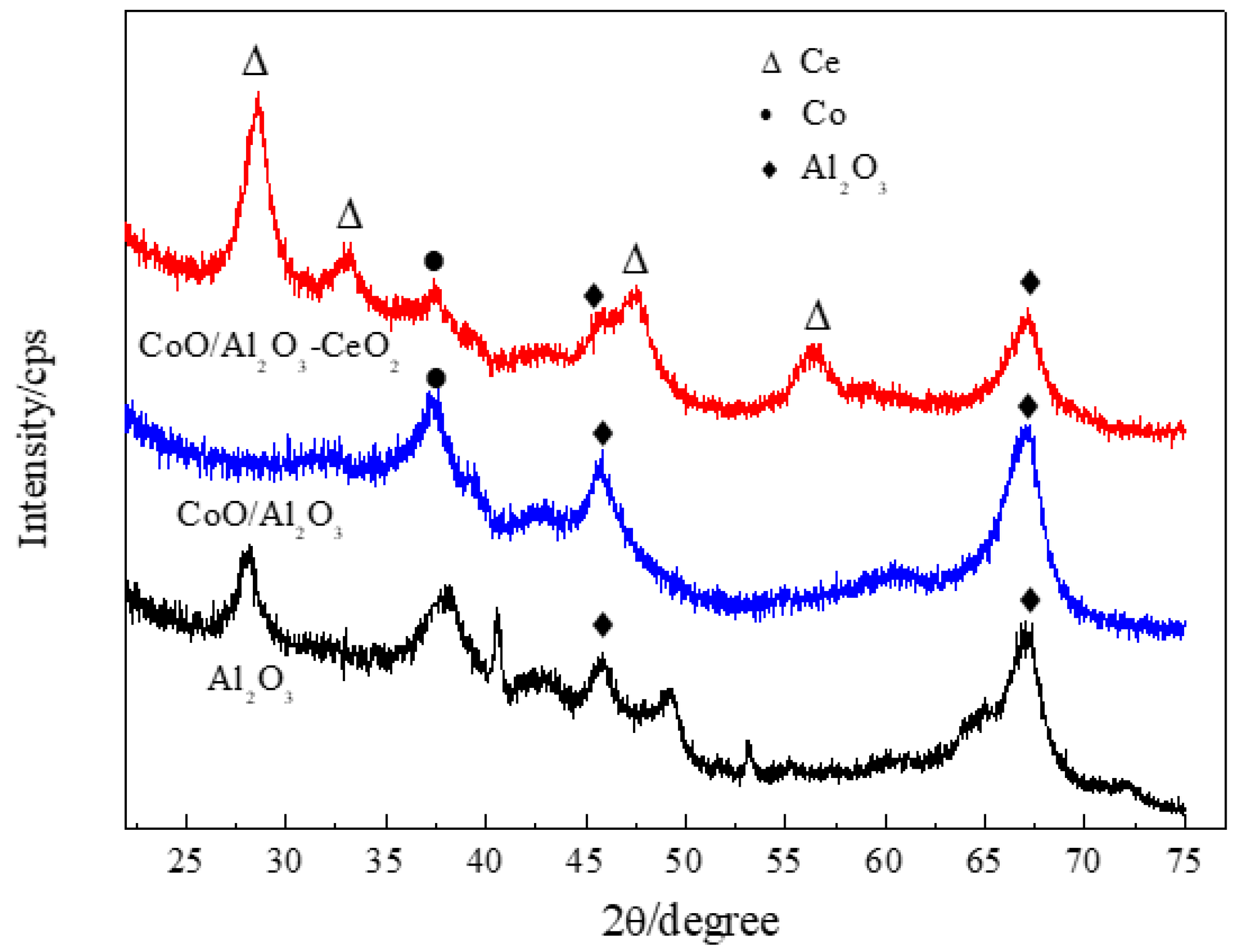
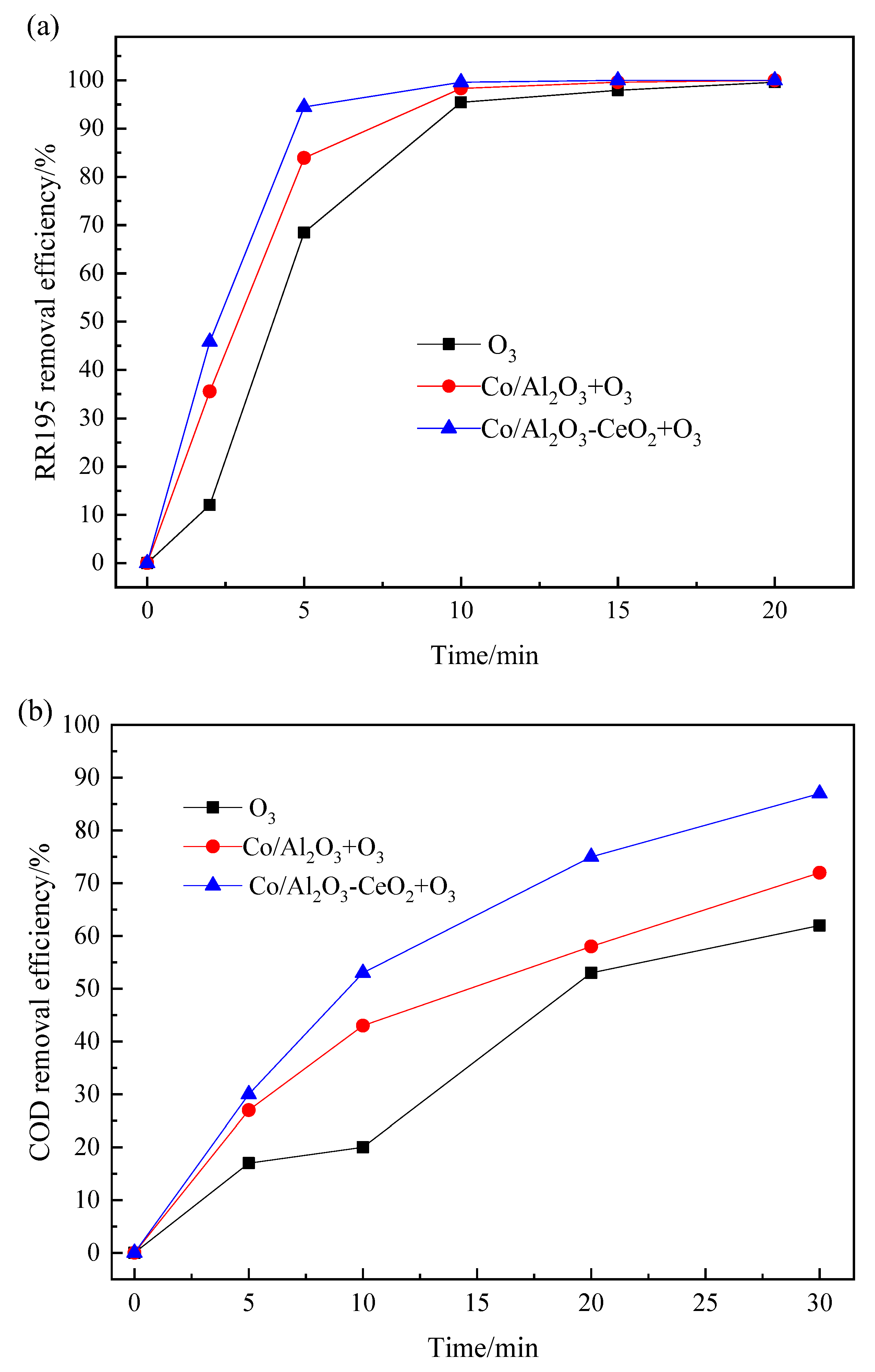

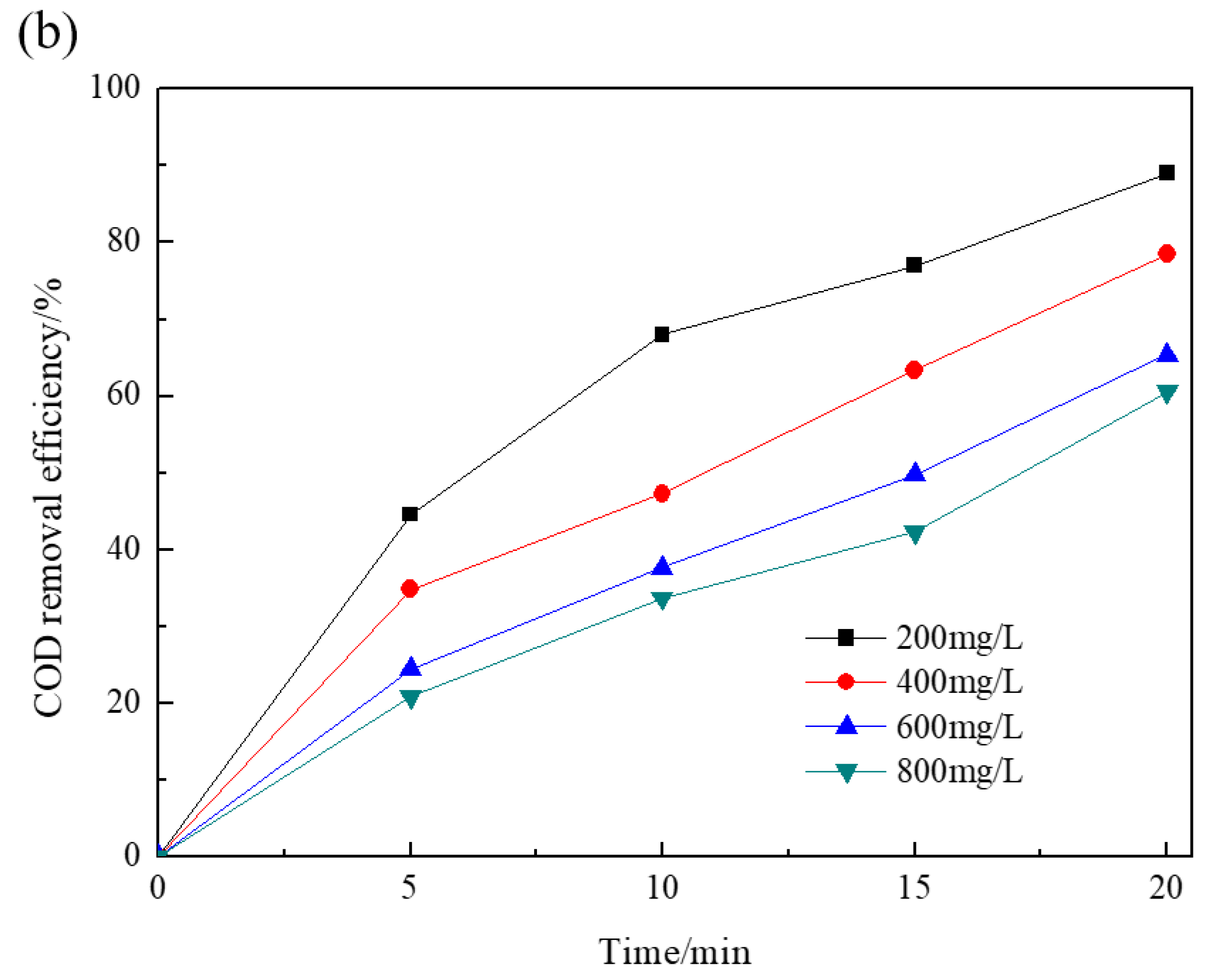
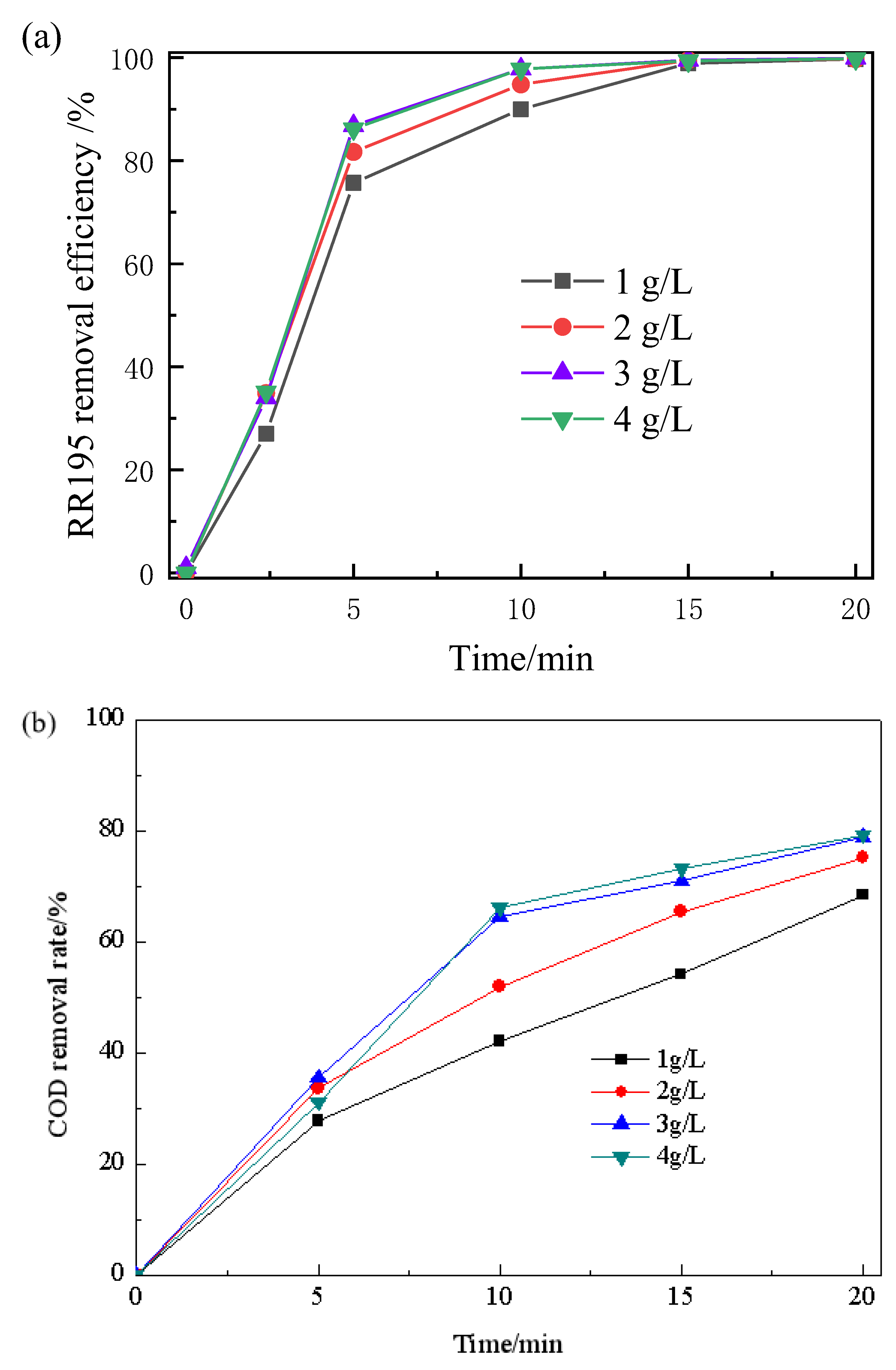


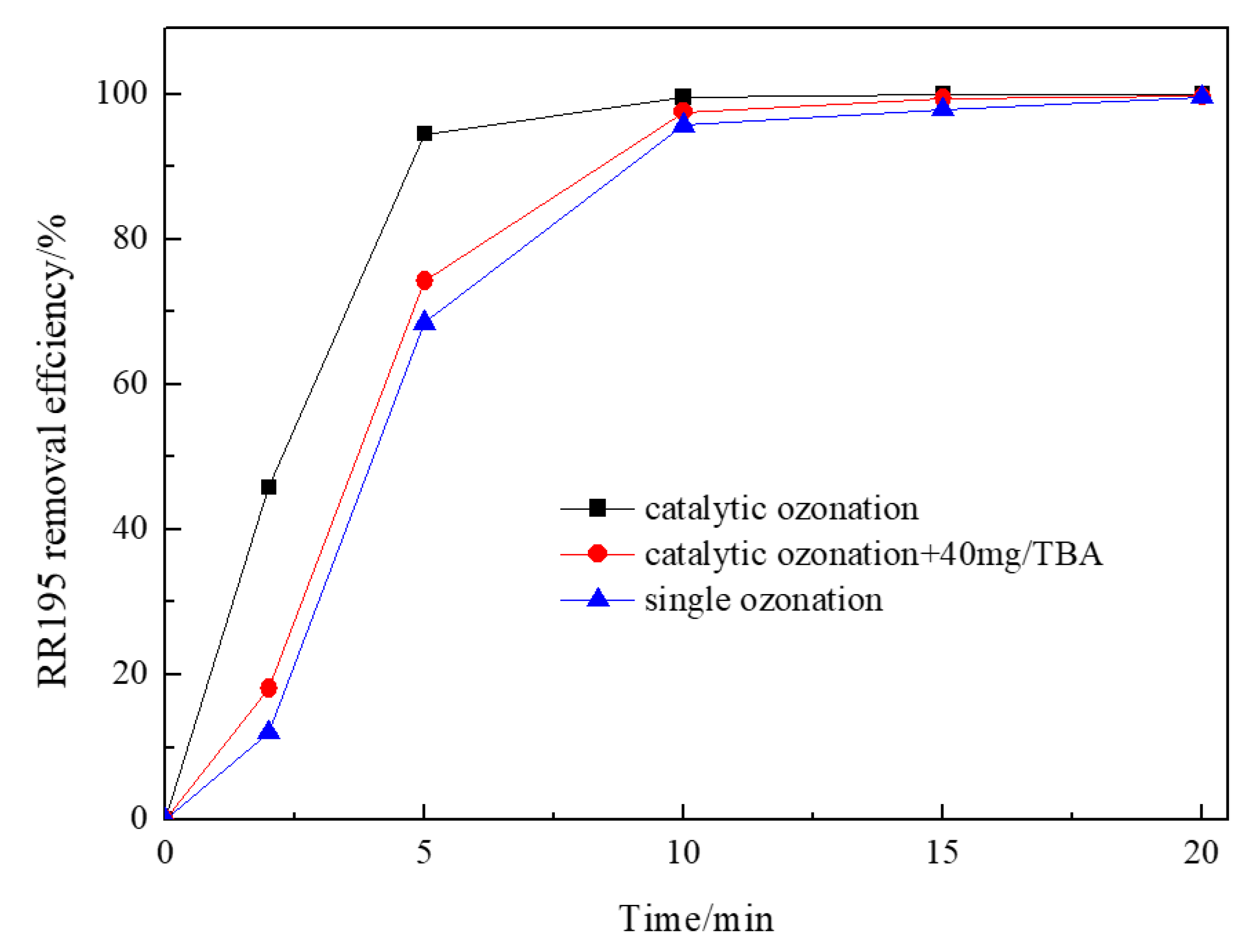

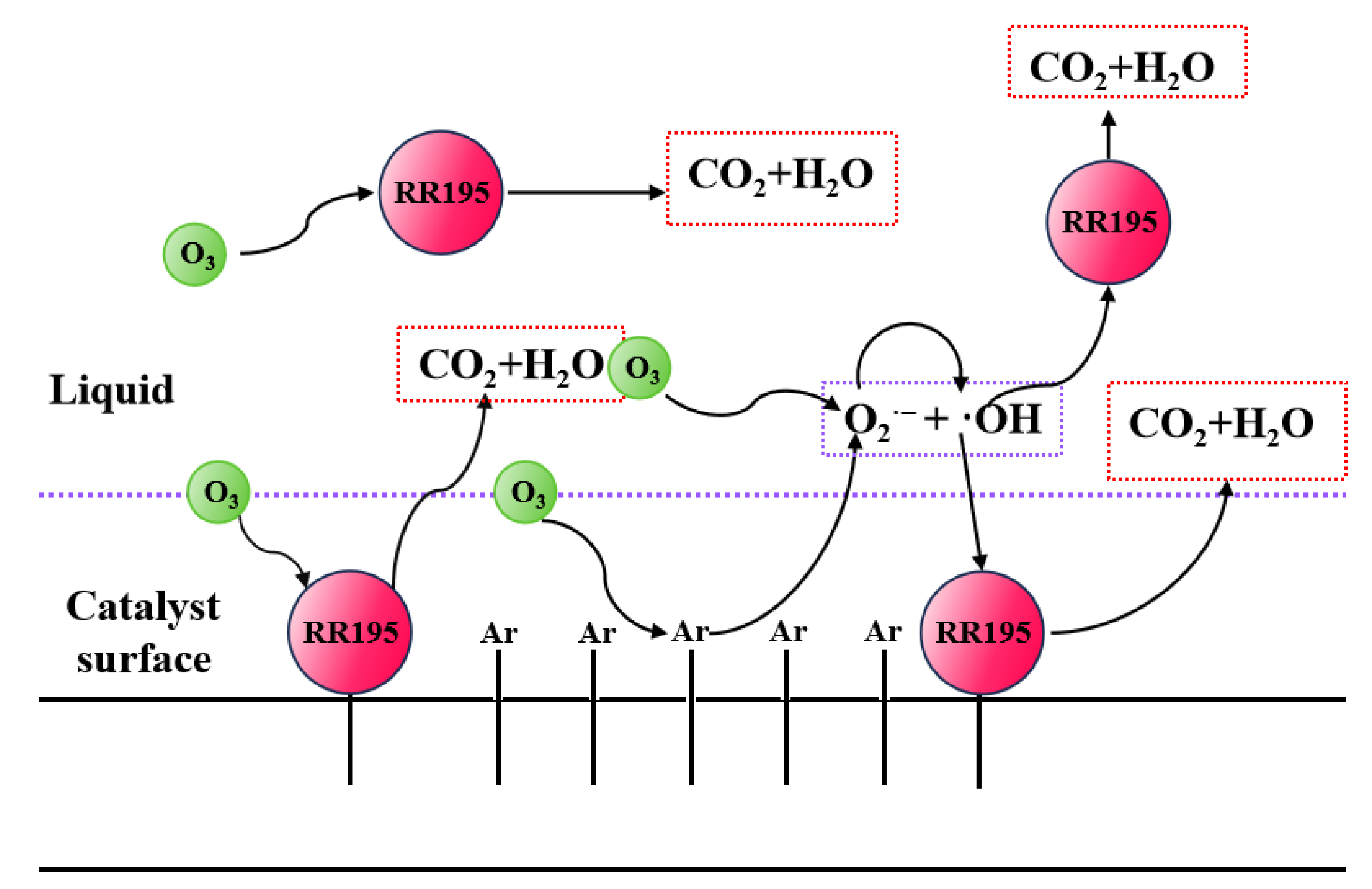
Disclaimer/Publisher’s Note: The statements, opinions and data contained in all publications are solely those of the individual author(s) and contributor(s) and not of MDPI and/or the editor(s). MDPI and/or the editor(s) disclaim responsibility for any injury to people or property resulting from any ideas, methods, instructions or products referred to in the content. |
© 2023 by the authors. Licensee MDPI, Basel, Switzerland. This article is an open access article distributed under the terms and conditions of the Creative Commons Attribution (CC BY) license (https://creativecommons.org/licenses/by/4.0/).
Share and Cite
Lv, B.-H.; Liu, X.-Y.; Zhou, Z.-M.; Jing, G.-H. Catalytic Ozonation of Reactive Red 195 in Aqueous Solution over a Cobalt/Aluminum Oxide-Ceria Catalyst. Processes 2023, 11, 2141. https://doi.org/10.3390/pr11072141
Lv B-H, Liu X-Y, Zhou Z-M, Jing G-H. Catalytic Ozonation of Reactive Red 195 in Aqueous Solution over a Cobalt/Aluminum Oxide-Ceria Catalyst. Processes. 2023; 11(7):2141. https://doi.org/10.3390/pr11072141
Chicago/Turabian StyleLv, Bi-Hong, Xiao-Yu Liu, Zhuo-Ming Zhou, and Guo-Hua Jing. 2023. "Catalytic Ozonation of Reactive Red 195 in Aqueous Solution over a Cobalt/Aluminum Oxide-Ceria Catalyst" Processes 11, no. 7: 2141. https://doi.org/10.3390/pr11072141



